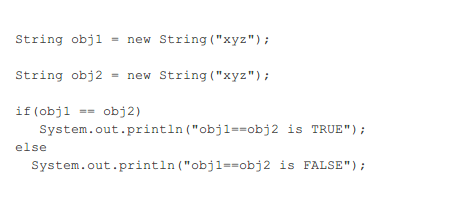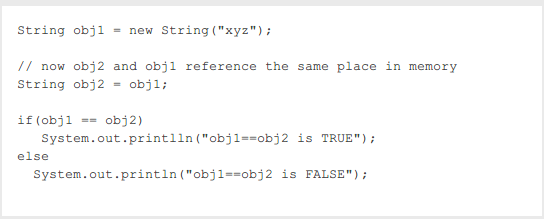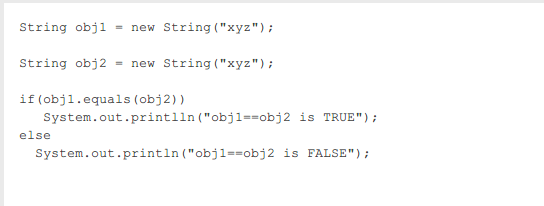淺談 Java 字符串
原文出處: 飄過的小牛
我們先要記住三者的特征:
- String 字符串常量
- StringBuffer 字符串變量(線程安全)
- StringBuilder 字符串變量(非線程安全) </ul>
- String:是不可改變的量,也就是創建后就不能在修改了。
- StringBuffer:是一個可變字符串序列,它與 String 一樣,在內存中保存的都是一個有序的字符串序列(char 類型的數組),不同點是 StringBuffer 對象的值都是可變的。
- StringBuilder:與 StringBuffer 類基本相同,都是可變字符換字符串序列,不同點是 StringBuffer 是線程安全的,StringBuilder 是線程不安全的。
一、定義
查看 API 會發現,String、StringBuffer、StringBuilder 都實現了 CharSequence 接口,內部都是用一個char數組實現,雖然它們都與字符串相關,但是其處理機制不同。
使用場景
使用 String 類的場景:在字符串不經常變化的場景中可以使用 String 類,例如常量的聲明、少量的變量運算。
使用 StringBuffer 類的場景:在頻繁進行字符串運算(如拼接、替換、刪除等),并且運行在多線程環境中,則可以考慮使用 StringBuffer,例如 XML 解析、HTTP 參數解析和封裝。
使用 StringBuilder 類的場景:在頻繁進行字符串運算(如拼接、替換、和刪除等),并且運行在單線程的環境中,則可以考慮使用 StringBuilder,如 SQL 語句的拼裝、JSON 封裝等。
分析
在性能方面,由于 String 類的操作是產生新的 String 對象,而 StringBuilder 和 StringBuffer 只是一個字符數組的擴容而已,所以 String 類的操作要遠慢于 StringBuffer 和 StringBuilder。
簡要的說, String 類型和 StringBuffer 類型的主要性能區別其實在于 String 是不可變的對象, 因此在每次對 String 類型進行改變的時候其實都等同于生成了一個新的 String 對象,然后將指針指向新的 String 對象。所以經常改變內容的字符串最好不要用 String ,因為每次生成對象都會對系統性能產生影響,特別當內存中無引用對象多了以后,JVM 的 GC 就會開始工作,那速度是一定會相當慢的。
而如果是使用 StringBuffer 類則結果就不一樣了,每次結果都會對 StringBuffer 對象本身進行操作,而不是生成新的對象,再改變對象引用。所以在一般情況下我們推薦使用 StringBuffer ,特別是字符串對象經常改變的情況下。
而在某些特別情況下, String 對象的字符串拼接其實是被 JVM 解釋成了 StringBuffer 對象的拼接,所以這些時候 String 對象的速度并不會比 StringBuffer 對象慢,而特別是以下的字符串對象生成中, String 效率是遠要比 StringBuffer 快的:
String S1 = “This is only a" + “ simple" + “ test"; StringBuffer Sb = new StringBuilder(“This is only a").append(“ simple").append(“ test");
你會很驚訝的發現,生成 String S1 對象的速度簡直太快了,而這個時候 StringBuffer 居然速度上根本一點都不占優勢。其實這是 JVM 的一個把戲,在 JVM 眼里,這個
String S1 = “This is only a" + “ simple" + “test";
其實就是:
String S1 = “This is only a simple test";
所以當然不需要太多的時間了。但大家這里要注意的是,如果你的字符串是來自另外的 String 對象的話,速度就沒那么快了,譬如:
String S2 = "This is only a"; String S3 = "simple"; String S4 = "test"; String S1 = S2 +S3 + S4;
這時候 JVM 會規規矩矩的按照原來的方式去做。
又及:
關于 equal 和 ==
== 用于比較兩個對象的時候,是來check 是否兩個引用指向了同一塊內存。

這個輸出就是false
這個輸出是true
一個特殊情況 :
這是因為:
字符串緩沖池:程序在運行的時候會創建一個字符串緩沖池。
當使用 String s1 = “xyz”; 這樣的表達是創建字符串的時候(非new這種方式),程序首先會在這個 String 緩沖池中尋找相同值的對象,
在 String str1 = “xyz”; 中,s1 先被放到了池中,所以在 s2 被創建的時候,程序找到了具有相同值的 str1
并將 s2 引用 s1 所引用的對象 “xyz”
equals()
equals() 是object的方法,默認情況下,它與== 一樣,比較的地址。
但是當equal被重載之后,根據設計,equal 會比較對象的value。而這個是java希望有的功能。String 類就重寫了這個方法
結果返回true
總的說,String 有個特點: 如果程序中有多個String對象,都包含相同的字符串序列,那么這些String對象都映射到同一塊內存區域,所以兩次new String(“hello”)生成的兩個實例,雖然是相互獨立的,但是對它們使用hashCode()應該是同樣的結果。Note: 字符串數組并非這樣,只有String是這樣。即hashCode對于String,是基于其內容的。
public class StringHashCode {
public static void main(String[] args) {
\\輸出結果相同
String[] hellos = "Hello Hello".split(" " );
System.out.println(""+hellos[0].hashCode());
System.out.println(""+hellos[1].hashCode());
\\輸出結果相同
String a = new String("hello");
String b = new String("hello");
System.out.println(""+a.hashCode());
System.out.println(""+b.hashCode());
}
}
結論
String 類是final類,不可以繼承。對String類型最好的重用方式是組合 而不是繼承。
String 有length()方法,數組有length屬性
String s = new String(“xyz”); 創建了幾個字符串對象?
兩個對象,一個靜態存儲區“xyz”, 一個用new創建在堆上的對象。
String 和 StringBuffer,String Builder區別?
在大部分情況下StringBuffer > String
Java.lang.StringBuffer 是線程安全的可變字符序列。一個類似于 String 的字符串緩沖區,但不能修改。雖然在任意時間點上它都包含某種特定的字符序列,但通過某些方法調用可以改變該序列的長度和內容。在程序中可將字符串緩沖區安全地用于多線程。而且在必要時可以對這些方法進行同步,因此任意特定實例上的所有操作就好像是以串行順序發生的,該順序與所涉及的每個線程進行的方法調用順序一致。
StringBuffer 上的主要操作是 append 和 insert 方法,可重載這些方法,以接受任意類型的數據。每個方法都能有效地將給定的數據轉換成字符串,然后將該字符串的字符追加或插入到字符串緩沖區中。append 方法始終將這些字符添加到緩沖區的末端;而 insert 方法則在指定的點添加字符。
例如,如果 z 引用一個當前內容是 “start”的字符串緩沖區對象,則此方法調用 z.append(“le”) 會使字符串緩沖區包含 “startle”( 累加); 而 z.insert(4, “le”) 將更改字符串緩沖區,使之包含 “starlet”。
在大部分情況下StringBuilder > StringBuffer
java.lang.StringBuilder 一個可變的字符序列是 JAVA 5.0 新增的。此類提供一個與 StringBuffer 兼容的 API,但不保證同步,所以使用場景是單線程。該類被設計用作 StringBuffer 的一個簡易替換,用在字符串緩沖區被單個線程使用的時候(這種情況很普遍)。如果可能,建議優先采用該類,因為在大多數實現中,它比 StringBuffer 要快。兩者的使用方法基本相同。
源碼
String,StringBuffer,StringBuilder都實現了CharSequence接口。
public class StringHashCode {
public static void main(String[] args) {
\\輸出結果相同
String[] hellos = "Hello Hello".split(" " );
System.out.println(""+hellos[0].hashCode());
System.out.println(""+hellos[1].hashCode());
\\輸出結果相同
String a = new String("hello");
String b = new String("hello");
System.out.println(""+a.hashCode());
System.out.println(""+b.hashCode());
}
} String的源碼
public final class String{
private final char value[]; // used for character storage
private int the hash; // cache the hash code for the string
} 成員變量只有兩個:
final的char類型數組
int類型的hashcode
構造函數
public String()
public String(String original){
this.value = original.value;
this.hash = original.hash;
}
public String(char value[]){
this.value = Arrays.copyOf(value, value.length);
}
public String(char value[], int offset, int count){
// 判斷offset,count,offset+count是否越界之后
this.value = Arrays.copyOfRange(value, offset, offset+count);
} 這里用到了一些工具函數
copyOf(source[],length);從源數組的0位置拷貝length個;
這個函數是用System.arraycopy(original, 0, copy, 0, Math.min(original.length, newLength))實現的。
copyOfRange(T[] original, int from, int to)。
構造函數還可以用StringBuffer/StringBuilder類型初始化String,
public String(StringBuffer buffer) {
synchronized(buffer) {
this.value = Arrays.copyOf(buffer.getValue(), buffer.length());
}
}
public String(StringBuilder builder) {
this.value = Arrays.copyOf(builder.getValue(), builder.length());
} 除了構造方法,String類的方法有很多,
length,isEmpty,可以通過操作value.length來實現。
charAt(int index):
通過操作value數組得到。注意先判斷index的邊界條件
public char charAt(int index) {
if ((index < 0) || (index >= value.length)) {
throw new StringIndexOutOfBoundsException(index);
}
return value[index];
} getChars方法
public void getChars(int srcBegin, int srcEnd,
char dst[], int dstBegin)
{
\\邊界檢測
System.arraycopy(value, srcBegin, dst, dstBegin, srcEnd - srcBegin);
} equals方法,根據語義相等(內容相等,而非指向同一塊內存),重新定義了equals
public boolean equals(Object anObject) {
if (this == anObject) {
return true;
}
if (anObject instanceof String) {
String anotherString = (String)anObject;
int n = value.length;
if (n == anotherString.value.length) {
char v1[] = value;
char v2[] = anotherString.value;
int i = 0;
while (n-- != 0) {
if (v1[i] != v2[i])
return false;
i++;
}
return true;
}
}
return false;
} 如果比較的雙方指向同一塊內存,自然相等;(比較==即可)
如果內容相等,也相等,比較方法如下:
首先anObject得是String類型(用關鍵字instanceof)
然后再比較長度是否相等;
如果長度相等,則挨個元素進行比較,如果每個都相等,則返回true.
還有現成安全的與StringBuffer內容比較
contentEquals(StringBuffer sb),實現是在sb上使用同步。
compareTo():
如果A大于B,則返回大于0的數;
A小于B,則返回小于0的數;
A=B,則返回0
public int compareTo(String anotherString) {
int len1 = value.length;
int len2 = anotherString.value.length;
int lim = Math.min(len1, len2);
char v1[] = value;
char v2[] = anotherString.value;
int k = 0;
while (k < lim) {
char c1 = v1[k];
char c2 = v2[k];
if (c1 != c2) {
return c1 - c2;
}
k++;
}
return len1 - len2;
} regionMatches:如果兩個字符串的區域都是平等的,
public boolean regionMatches(int toffset, String other, int ooffset,
int len)
{
//判斷邊界條件
while (len-- > 0) {
if (ta[to++] != pa[po++]) {
return false;
}
}
}
public boolean regionMatches(boolean ignoreCase, int toffset,
String other, int ooffset, int len)
{
while (len-- > 0) {
char c1 = ta[to++];
char c2 = pa[po++];
if (c1 == c2) {
continue;
}
if (ignoreCase) {
// If characters don't match but case may be ignored,
// try converting both characters to uppercase.
// If the results match, then the comparison scan should
// continue.
char u1 = Character.toUpperCase(c1);
char u2 = Character.toUpperCase(c2);
if (u1 == u2) {
continue;
}
// Unfortunately, conversion to uppercase does not work properly
// for the Georgian alphabet, which has strange rules about case
// conversion. So we need to make one last check before
// exiting.
if (Character.toLowerCase(u1) == Character.toLowerCase(u2)) {
continue;
}
}
return false;
}
return true;
} startsWith(String prefix, int toffset)
startsWith(String prefix)
endsWith(String suffix)
{
return startsWith(suffix, value.length
- suffix.value.length);
} substring(int beginIndex,int endIndex)
除了條件判斷:
return (beginIndex == 0) ? this : new String(value, beginIndex, subLen);
字符串連接concat(String str)
int otherLen = str.length();
if (otherLen == 0) {
return this;
}
int len = value.length;
char buf[] = Arrays.copyOf(value, len + otherLen);
str.getChars(buf, len);
return new String(buf, true); 對于StringBuffer和StringBuilder
StringBuffer 和 StringBuilder 都是繼承于 AbstractStringBuilder, 底層的邏輯(比如append)都包含在這個類中。
public AbstractStringBuilder append(String str) {
if (str == null) str = "null";
int len = str.length();
ensureCapacityInternal(count + len);//查看使用空間滿足,不滿足擴展空間
str.getChars(0, len, value, count);//getChars就是利用native的array copy,性能高效
count += len;
return this;
} StringBuffer 底層也是 char[], 數組初始化的時候就定下了大小, 如果不斷的 append 肯定有超過數組大小的時候,我們是不是定義一個超大容量的數組,太浪費空間了。就像 ArrayList 的實現,采用動態擴展,每次 append 首先檢查容量,容量不夠就先擴展,然后復制原數組的內容到擴展以后的數組中。



